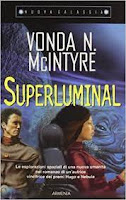Like many sf writers of the 20th century, Vonda McIntyre opted to take a successful novella and extend it. “Aztecs” was published in 1977, and six years later, readers were able to experience the novel treatment, Superluminal (1983). As with all such revisits, the questions are: how does McIntyre extend the narrative, and does it enhance the experience?
The opening of Superluminal is the novella “Aztecs”—which answers the first question; the novel picks up where the novella left off to tell what happens next. A woman, Laenae, comes to consciousness having recently completed surgery which replaced her heart with a mechanical pump. Necessary for long distance space flight, Laenae has sacrificed her body’s core to be one of the rare few who can call themselves “Pilot”. But that is only the first step. Fully understanding the impact of her decision requires a deeper look at relationships and people who have taken similar decisions as herself.
Extending the novella, McIntyre adds two additional characters. First is Laenae’s lover—whose relevance is clear in the moment, and becomes a counter-point as she takes her first pilot job. The second is not immediately relevant, save the fact she too is a woman who underwent body modification to survive in a specific environment; Orca is a woman who lives underwater on another planet. Gills, flippers, webbing, etc. are all part of her physique. Slowly—slowly—McIntyre weaves these characters in and out of one another’s lives across the galaxy.
In reviewing “Aztecs” I wrote that McIntyre tells a New Wave story focusing on self-perception and adjusting to the inevitable changes that choice and life bring our way. Superluminal certainly extends this theme. But rather than one woman’s experience in a novella-length examination, readers experience a novel-length perspective through the eyes of three characters.
But it’s not convincing that more is better. Superluminal expends almost all its calories on the thoughts, emotions, and relationship implications, all inside lengthy scenes. This is all well and good, save the fact there is no underlying plot motivation to keep the scenes linked in momentum-building fashion—to keep the pages turning, as they say. What exists is almost entirely dependent on deep anxiety and angst. This works in short length fiction, e.g. the novella, but McIntyre struggles to make it work novel-length without more plot elements to motivate the undercurrent of reader engagement.
On the whole, the novella “Aztecs” remains the better piece of writing. Which is a pity. It’s clear that in Superluminal McIntyre is attempting to extend the characters and theme in the same, in-depth fashion—something with real, relatable human depth. But to go back to the original question: does the novel-length treatment enhance the experience? The answer is technically yes; there is more content. But the novella remains the more focused, purposeful, and impacting reading experience. “Aztecs” is a subtle but tight human punch, whereas Superluminal spreads itself thin, losing momentum and deeper effect in the process. Readers for whom plot is not as important as character, emotion, and relationships may find the novel enticing, however. But I would suggest reading the novella first to gauge interest. It can be found in the recommended collection Fireflood and Other Stories.


Well it was certainly a very feelsy mind screw XD and there are a few holes left in the story, does anyone actually know what the Divers' proposed "transition" was supposed to be? It just adds more confusion than dramatic tension.
ReplyDelete